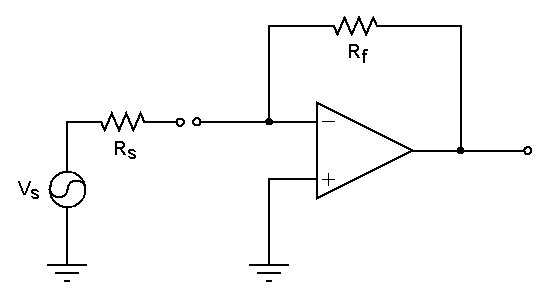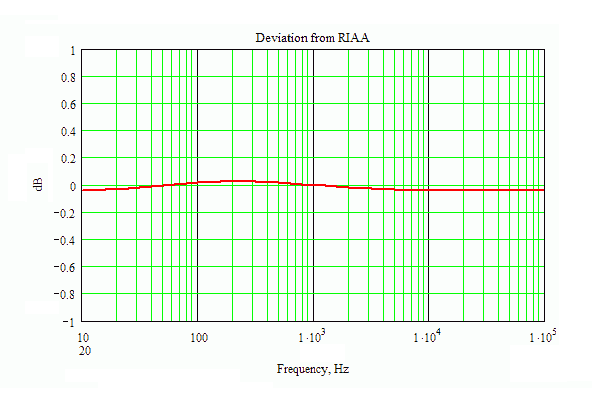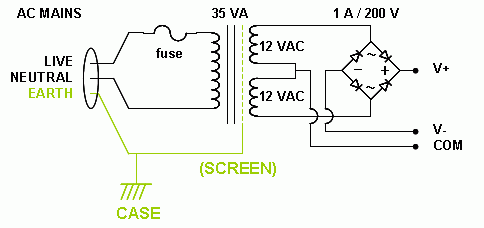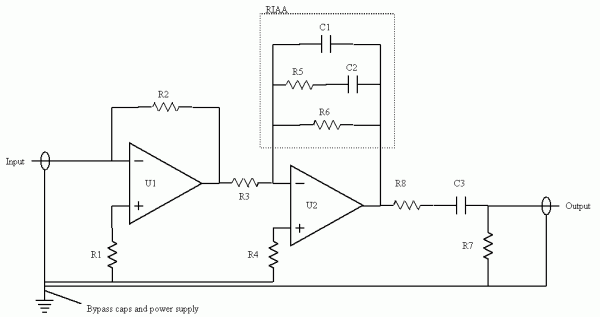The Phonoclone!
47 Labs redux.
The Model 4712 Phonocube from 47 Laboratories is an op-amp based phono preamplifier for moving coil cartridges. The gain is extremely high, 75 dB or 90 dB, and, mysteriously, the input impedance is given as "zero ohms". Interesting. Well, we cracked the DAC and cloned the 'Card, so why not try and copy the 'Cube?
Important Note: this schematic will only work with low output moving coil phono cartridges. For moving magnets and high output moving coils please see the VSPS project.
The Amplifier Circuit
Zero input impedance seems strange, but there is a way to acheive this with op-amps and still measure the cartridge output. Consider the simple inverted topology:

The inverting terminal is a virtual ground, thus the input impedance is just Rin. When Rin is removed the input impedance is zero. The amplifier becomes a current-to-voltage (I/V) converter. The MC cartridge is a voltage source, however, and when connected to the input of the I/V converter the net result looks like a standard inverting amplifier again, only with the input resistor replaced by the internal impedance of the cartridge Rs.

The voltage gain is Vout / Vs = Rf / Rs, where Vs is the open circuit output voltage of the cartridge. A "zero impedance" input stage allows an inverting topology to be used without adding extra noise generated by the input resistor. The impedance of the cartridge must be relatively constant over the audio band, however, or else the frequency response will deviate significantly from the manufacturers specification.
The Phonoclone, the following 13 part circuit, is the input stage described above coupled to an inverting output stage. Somehow it all fell together once I got started.
Apart from R8, which must be 47 ohms to satisfy the specified output impedance, the remaining values are based on a few educated estimations and a series of cascading guesses.
| Component | Value | Description |
|---|---|---|
| R1 | 47R | Choose a value to roughly balance the cartridge impedance. May be omitted altogether. |
| R2 | 1k5 | Normally 1k5 is fine, but may be adjusted as needed to set the gain. (see below) Try to avoid values below 500 ohms. |
| R3 | 2k2 | Needs to be low for low noise, but high to avoid loading the output of IC1. |
| R4 | 2k2 | Set to balance R3. May be omitted altogether. |
| R5 | 110k | RIAA |
| R6 | 750k | RIAA |
| R7 | 33k | Keeps the output at zero volts DC. Value not critical. |
| R8 | 47R | Defines the output impedance. Isolates the output stage from cable capacitance, improving stability. |
| C1 | 1.00nF | RIAA |
| C2 | 2.90nF | RIAA (2.2nF||0.68nF) |
| C3 | 4.7µF | Output coupling. Must be non-polar. |
| U1 | OP27 | Input stage. |
| U2 | OP27 | Output stage. |
RIAA values shown in bold. The exact values shown theoretically give a response accurate to 0.01 dB.

The second stage, with its inverting topology and active equalization is unusual in phono preamps. Buffered as it is here by an op-amp input stage, however, it's ideal. Unlike a non-inverting active stage the gain can fall below unity, allowing the RIAA curve to be traced accurately at high frequencies. With active equalization the signal is attenuated by the variable application of feedback rather than sampling only a portion of the available signal as with a passive stage. The benefit is higher overall gain and lower noise compared to a similar circuit with passive equalization.
The mid-band gain of the second stage is roughly 0.6 R5/R3. As shown it is 33, or 30 dB. The gain of the first stage is R2/Rs, where Rs is the cartridge impedance. When using the OP27, the gain of the first stage should be set to about 45 dB ( R2 = 180 x Rs ) to get the stated total gain of 75 dB. For a 90 dB gain version, set the first stage gain to 60 dB ( R2 = 1000 x Rs ) and substitute a OP37 or similar decompensated op-amp instead of of the OP27.
It has not been possible to get the high gain version of the phonoclone to work, though. Also, personally, I prefer to lower the first stage gain to 30 dB or thereabouts ( R2 = 30 x Rs ). Most people should have no problem just using the recommended R2 value of 1.5 kohms.Power Supply
The phonoclone is best used with an external unregulated power supply:

The transformer should have two 12 VAC secondary windings. A good basic choice is a 35 VA toroid, e.g. Talema 62072 (Digikey part no. TE62072-ND). Large toroidal or R-core transformers 100 VA or more are recommended for improved performance, e.g. Plitron. Much of the quality of the sound depends on the power transformer, so don't skimp on this part just because the current demands are only a few milliamps. Rectifying diodes (200 V / 1 A or larger) and a fuse rounds out the required componentry. Two power supplies can be used for true dual mono operation.
Voltage Regulation
The voltage regulation circuit including the filtering and bypass capacitors are normally all placed as close to the amplifier as possible. The simplest version consists of fixed voltage 3-pin regulators, e.g. LM7812 and LM7912, with electrolytic capacitors on the inputs and outputs. The input capacitors are around 220 µF to 1000 µF, while the output capacitors should be smaller, typically 220 µF or less. Make sure the voltage rating is 25 V or higher.

Substituting high performance regulators can improve the sound quite dramatically.
Layout
Several different printed circuit boards are available for this project. The differences lie mainly in the voltage regulation used. Some versions use adjustable LM317 and LM337 regulators, others add RC filtering between the voltage regulator and the op-amp. In the most recent iteration, the Phonoclone 3, the regulators have been replaced by the Xreg voltage stabilizer circuit.
Construction
Please see the Construction Guide for additional hints and tips for building this project.
rjm003.geo at yahoo.com

|
